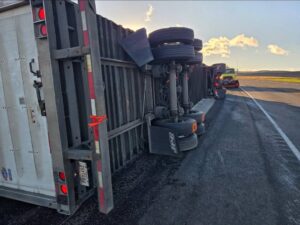WASHINGTON — On April 27, 46 jurisdictions in Canada and the U.S. removed 1,290 commercial motor vehicles with brake-related critical vehicle inspection item violations from Canadian and American roadways, according to the Commercial Vehicle Safety Alliance (CVSA).
That’s 14.1% of the 9,132 commercial motor vehicles inspected that day.
This unannounced, one-day inspection and enforcement initiative, conducted by members of the CVSA, focuses specifically on the brake systems and components on commercial motor vehicles.
On Brake Safety Day, CVSA-certified inspectors conduct their usual commercial motor vehicle inspections; however, in addition, for this initiative, they also reported brake-related data to the alliance.
QUICK STATS
- Forty-six jurisdictions participated.
- A total of 9,132 inspections were conducted.
- Of the total number of inspections conducted, 1,290 vehicles were placed out of service.
- The brake-related out-of-service rate was 14.1%.
VIOLATIONS
- A category 1 violation is when the wear extends into the outer protective material. Thirty-two percent of brake hose/tubing chafing violations were identified as this category. A category 1 violation is not an out-of-service condition.
- Category 2 is when wear extends through the outer protective material into the outer rubber cover. This is not an out-of-service violation. The largest category, 37% of brake hose/tubing chafing violations were category 2.
- In category 3, wear has made the reinforcement ply visible, but the ply remains intact. Thirteen percent of brake hose/tubing chafing violations were identified as category 3, which is not an out-of-service violation.
- In category 4, chafing has caused any part of the fabric/steel brain reinforcement ply to be frayed, severed or cut through. This is an out-service-condition. Eighteen percent of brake hose/tubing chafing violations were category 4.
On April 1, CVSA updated the North American Standard Out-of-Service Criteria to amend category 4 to make any tubing/hose damage resulting in the fabric/steel braid reinforcement ply being frayed, damaged or cut an out-of-service violation.
Compared to last year, the new category 4 brake hose/tubing chafing violations, as a portion of total brake hose/tubing chafing violations, increased modestly from 17% to 18%, even when accounting for what amounts to combining of categories 4 and 5 from 2021.
In addition, CVSA member jurisdictions equipped with performance-based brake testers (PBBTs) participated in Brake Safety Day activities, conducting 92 inspections with PBBTs, resulting in six, or 6.5%, commercial motor vehicles being placed out of service for insufficient overall vehicle braking efficiency.
CVSA conducts two major brake-safety inspection and enforcement initiatives each year.
One is this initiative, a one-day unannounced brake-safety campaign. CVSA does not provide advance notice or warning for Brake Safety Day.
The other campaign, Brake Safety Week, is publicly announced well in advance and lasts for a week. This year’s Brake Safety Week is scheduled for Aug. 21-27.
Brake Safety Day and Brake Safety Week are part of CVSA’s Operation Airbrake program in partnership with the U.S. Federal Motor Carrier Safety Administration, the Canadian Council of Motor Transport Administrators and Mexico’s Ministry of Communications and the National Guard.
“Operation Airbrake is a comprehensive program dedicated to improving commercial motor vehicle brake safety throughout North America,” according to the CVSA. “The goal is to reduce the number of highway crashes caused by faulty braking systems on commercial motor vehicles by conducting roadside inspections and educating drivers, mechanics, owner-operators and others on the importance of proper brake inspection, maintenance and operation.”
The Trucker News Staff produces engaging content for not only TheTrucker.com, but also The Trucker Newspaper, which has been serving the trucking industry for more than 30 years. With a focus on drivers, the Trucker News Staff aims to provide relevant, objective content pertaining to the trucking segment of the transportation industry. The Trucker News Staff is based in Little Rock, Arkansas.















